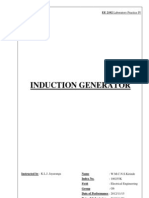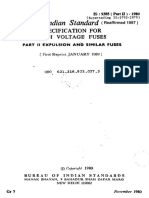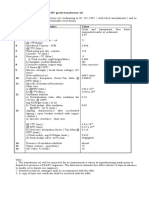Simple Power Transformer Winding Calculation Tutorial
Uploaded by
Stephen HowardSimple Power Transformer Winding Calculation Tutorial
Uploaded by
Stephen HowardMarko Delac
Delatsch Electronics
2018. March 23.
Simple Power Transformer
Winding Calculation Tutorial
Practical way to wind your own transformers
Winding your own power and output transformer puts in you in a very convenient
position when making or designing a piece of electronics gear. It gives you freedom to
experiment, upgrade an existing transformer or create a completely new design that simply
cannot be found among the off the shelf transformers available. By being able to wind a
custom power and output transformers according to your needs and preferences, you can
control the end product you are creating and building in a significant way. By using multiple
voltage taps which stock transformers lack, or simply not using some of the taps stock
transformers come with can be a great advantage by itself. For example, if you are designing a
guitar preamplifier which requires relatively small amounts of current, but you need a high
voltage winding and thinner gauge for the heater wires (if you want to use 12.6 volts instead
of 6.3V which is more current efficient and less noisy) You also don’t need the 5V winding the
stock transformer came with. So, you can wind a custom transformer that will have all the
features you need, and at the same time not have the features you don’t need — making the
transformer significantly lighter and more compact than the stock transformers available.
To calculate the power transformer for any project the rules are more or less the same.
You should start by calculating the power consumption of your secondary voltages. For guitar
tube amplifiers you can check the current rating for your voltages from the existing
transformer’s data sheet. Just find the transformer from the known amplifier that uses the
same kind of tubes and same or similar number of tubes. You can also check the tube data
sheet for the tubes you are using and find the plate current rating there.
For our example we will calculate the power transformer for 5e3 tube amplifier. It
consists of a primary winding which will be connected to the mains voltage (so you can use
nominal frequency and voltage of your wall outlet for your country or region, I’ve used 50Hz
SIMPLE PT WINDING CALCULATION TUTORIAL !1
in cell B3 and 230V in cell D4 of the metric version of the spreadsheet and 60Hz and 120V
for the imperial version) and three secondary windings for different voltages we need for our
tubes. For the B+ voltage for the plates of 6V6s tubes we need 650V. (Don’t forget to divide
the number of turns by two and connect the end of one winding to the beginning of the
other winding when it comes to the practical winding part) If you check the schematic you
will notice that the B+ winding is a winding with a centre tap. That means that we have two
325V windings connected together and the point where they are joined together is then
connected to the ground in our amplifier. We can see from the tube data sheet that the
current rating for the two 6V6 tubes in AB1 configuration or PP configuration is around
70-80mA. So with couple of preamp tubes we can use that voltage 650 in cell D6 and the
current rating 0,08 in cell E6 (the 12AX7 and 12AY7 have an extremely low plate current
(couple of mAs). For our 5Y3 rectifier tube filament we need 5V at 2A. So, we type 5 in cell
D8 and 2 in cell E8. For the rest of the tube filaments we need 6,3V rated at 3A. So we type
6,3 in cell D10 and 3 in cell E10. You will see that just from these inputs alone most of the
other cells marked in red are automatically filled in. You shouldn’t edit the cells marked in red
manually.
The other white or blank fields we need to take care of are the magnetic flux density,
core cross section and lamination window length and width. If you are using the regular 4%
silicon steel transformer core or you don’t know the quality of the core you are using you can
use the nominal value of 10000 gauss for magnetic flux density (cell B4). Otherwise use the
value recommended by the manufacturer. The magnetic flux density is often specified in
Teslas or T. The equivalent value of 10000Gs is 1T. According to the power consumption of
your transformer cell B6 or “minimal recommended cross section size” will be calculated for
you. You could in some cases use a core which is a bit smaller than that but I definitely
wouldn’t recommend it for your first transformer. You should always go for the next higher
value at least. No matter what core size you choose, don’t forget to type it into cell B7. Since
the EI laminations come in standard sizes, you want to choose the value which will be more
or less square. Now, also from the practical standpoint you don’t want to use the laminations
which are too big because they might take too much space on your chassis. So, you should
find an optimum there. For example, our calculation shows that the minimal recommended
cross section should be around 10,1 cm2. That means that if we use EI84 laminations (which
will fit the original chassis) of which the mid section is 28mm wide, we could use a bobbin
which is 45mm tall (28x45mm is a standard available plastic bobbin size. I would recommend
SIMPLE PT WINDING CALCULATION TUTORIAL !2
using standard plastic bobbins for your first builds. They usually come in sizes which are
square with the standard centre leg lamination sizes and also couple of larger values if you
need to fit more core into the bobbin. For example, for EI84 we have 28x28, 28x35, 28x40,
28x45, 28x50mm as standard bobbin sizes). That would give us a cross section of 12,6cm2 (,
which would be meet the requirements and still fit the chassis. Of course we still need to
double check wether or not our windings will fit the bobbin. To do that, we check the length
and width of our lamination’s window. For our selected EI84 laminations the window
dimensions are — length 4,2cm (1.65”) (cell B9) and the width 1,4cm (0.55”) (cell B10). To
check whether the windings will fit to the selected core size or bobbin size, the value of cell
B14 should be around 80-85 percent the most.
Now bear in mind that the value of E4 is calculated according to the nominal values for
your wire thicknesses. We can use a slightly thinner gauge wire than specified since these
values are pretty conservative, but don’t go too far. Try to stick to the specified values as close
as you can. Using thinner wire will cause the transformer to produce more heat and might
cause it to fail eventually.
For heater or filament windings always use couple of more windings than specified since
they will have most of the losses. For example for the 5V winding use 19 turns. And for 6,3V
winding use 24 turns.
Make sure to use both masking tape and pressboard between primary and secondary
windings and between each separate secondary winding. If you are using double coated
enamelled wire that can withstand 200 degrees celsius than you don’t have to use the pressed
paper between two sides of windings with the centre tap, masking tape is fine.
When assembling the laminations, start with the E laminations and insert one
lamination from one side of the bobbin and the other lamination from the opposite side.
Then add the I laminations to the empty space between the E laminations.
Pot the transformer in beeswax or resin to protect the windings and prevent laminations
from buzzing.
You are now ready to go winding!
SIMPLE PT WINDING CALCULATION TUTORIAL !3
You might also like
- Derivation of Formula For Calculation of Turns Per Volts of Transformer Design100% (2)Derivation of Formula For Calculation of Turns Per Volts of Transformer Design15 pages
- Computation of Transformer Losses Under The Effects of Non-Sinusoidal CurrentsNo ratings yetComputation of Transformer Losses Under The Effects of Non-Sinusoidal Currents14 pages
- How To Calculate The Suitable Capacitor Size in Farads & kVAR For Power Factor Improvement (Easiest Way Ever) - Electrical Technology PDFNo ratings yetHow To Calculate The Suitable Capacitor Size in Farads & kVAR For Power Factor Improvement (Easiest Way Ever) - Electrical Technology PDF6 pages
- S11 IEEE IEC ComparisonReport On TransformersNo ratings yetS11 IEEE IEC ComparisonReport On Transformers12 pages
- Example 3500 - 1600kVA Oil TX-Liquid Distribution Transformer SpecificationNo ratings yetExample 3500 - 1600kVA Oil TX-Liquid Distribution Transformer Specification24 pages
- 02 - Capacitor Panel - 1 (1300 Kvar) (Substation - 3)No ratings yet02 - Capacitor Panel - 1 (1300 Kvar) (Substation - 3)3 pages
- Study of 220kv Network in Visakhapatnam Steel Plant100% (1)Study of 220kv Network in Visakhapatnam Steel Plant19 pages
- CESI Short Circuit Withstand Test Dry Type Transformer Imefy 1500 11No ratings yetCESI Short Circuit Withstand Test Dry Type Transformer Imefy 1500 1121 pages
- Installation Troubleshooting Capacitors APFCSystem100% (1)Installation Troubleshooting Capacitors APFCSystem23 pages
- Day 1 Paper 1 Specification Enhancement For Reliability and Alignment With Latest Standards MR ShashankKulkarni SIEMENSNo ratings yetDay 1 Paper 1 Specification Enhancement For Reliability and Alignment With Latest Standards MR ShashankKulkarni SIEMENS9 pages
- Indian Standard: Specification For High Voltage FusesNo ratings yetIndian Standard: Specification For High Voltage Fuses28 pages
- Calculation of Voltage Drop and Cable Size For Motor / Elect - LoadNo ratings yetCalculation of Voltage Drop and Cable Size For Motor / Elect - Load33 pages
- Transformer Protection: Department of Electrical Engineering Institute of Southern PunjabNo ratings yetTransformer Protection: Department of Electrical Engineering Institute of Southern Punjab20 pages
- Client - Consultant - Contractor - Project: Package-Ii: Doc. Name: Design Calculation Sheet For HT Power Cable Document No.No ratings yetClient - Consultant - Contractor - Project: Package-Ii: Doc. Name: Design Calculation Sheet For HT Power Cable Document No.2 pages
- Inrush Current Limiting Coil CalculationNo ratings yetInrush Current Limiting Coil Calculation1 page
- 33kV - Cap - Bank-SIKAP - Spec - FY 12-13 - 30.11.11-Cesc - 20 MVARNo ratings yet33kV - Cap - Bank-SIKAP - Spec - FY 12-13 - 30.11.11-Cesc - 20 MVAR9 pages
- 1.6 MVA Oil Type Transformer GTP - Mar22-20110% (1)1.6 MVA Oil Type Transformer GTP - Mar22-201115 pages
- Three Phase Induction Motors: Output Equation of Induction MotorNo ratings yetThree Phase Induction Motors: Output Equation of Induction Motor7 pages
- Special Session - Neeraj Goyal - Co-Chairman - TRAFOTECH 2018No ratings yetSpecial Session - Neeraj Goyal - Co-Chairman - TRAFOTECH 201825 pages
- Tech Specification For Dist. TransformerNo ratings yetTech Specification For Dist. Transformer19 pages
- Modeling and Simulation of A 24-Pulse Transformer Rectifier Unit For More Electric Aircraft Power SystemNo ratings yetModeling and Simulation of A 24-Pulse Transformer Rectifier Unit For More Electric Aircraft Power System5 pages
- Design and Implementation of A 5 kVA InverterNo ratings yetDesign and Implementation of A 5 kVA Inverter22 pages
- Calculations For Design Parameters of TransformerNo ratings yetCalculations For Design Parameters of Transformer3 pages



























































